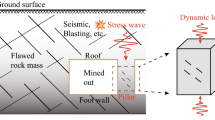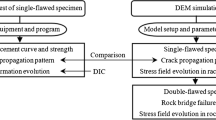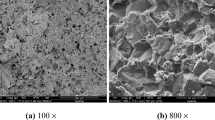Abstract
Cracking behavior of flawed samples has been extensively studied in rocks and rock-like materials using experimental and numerical approaches. However, the existing research mainly focuses on the effects of flaw length l and inclination angle α on rock mechanical behavior, a limited attention has been given to understand the role of flaw width b on crack initiation and propagation in relation to mechanical parameters of rocks. In this paper, a two-dimensional particle flow code (PFC2D)-based synthetic rock model, which is calibrated by the laboratory sandstone properties, is used to investigate the effects of flaw width on cracking behavior of single-flawed rock samples under uniaxial compression tests. Numerical simulation results show that the flaw width b has significant effects on the crack geometrical parameters (crack initiation location d and crack initiation angle θ). The values of θ and d significantly decrease with the increase of flaw width when b < 1.0 mm and their values tend to be stable with the further increase of flaw widths. It is also found that the mechanical properties (uniaxial compressive strength UCS and deformation modulus Es) of flawed rock samples are related to the crack geometrical parameters (θ and d) and the effects of flaw width on the values of UCS and Es of single-flawed rock specimens is significant when b < 1.0 mm for lower crack inclination angle (α < 60°).














Similar content being viewed by others
References
Basu A, Mishra D, Roychowdhury K (2013) Rock failure modes under uniaxial compression, Brazilian, and point load tests. Bull Eng Geol Environ 72(3–4):457–475
Cao R, Cao P, Lin H, Pu C, Ou K (2016) Mechanical behavior of brittle rock-like specimens with pre-existing fissures under uniaxial loading: experimental studies and particle mechanics approach. Rock Mech Rock Eng 49(3):763–783
Cho N, Martin C, Sego D (2007) A clumped particle model for rock. Int J Rock Mech Min Sci 44(7):997–1010
Cundall PA, Potyondy DO (2004) A bonded-particle model for rock. Int J Rock Mech Min Sci 41(8):1329–1364
Figueiredo B, Tsang C, Rutqvist J, Niemi A (2017) The effects of nearby fractures on hydraulically induced fracture propagation and permeability changes. Eng Geol 228:197–213
Gao W, Dai S, Xiao T, He T (2017) Failure process of rock slopes with cracks based on the fracture mechanics method. Eng Geol 231:190–199
Huang F, Shen J, Cai M, Xu C (2019) An empirical UCS model for anisotropic blocky rock masses. Rock Mech Rock Eng. https://doi.org/10.1007/s00603-019-01771-2
Itasca (2011) PFC2D (two-dimensional particle flow code), <www.itascacg.com>
Jin J, Cao P, Chen Y, Pu C, Mao D, Fan X (2017) Influence of single flaw on the failure process and energy mechanics of rock-like material. Comput Geotech 86:150–162
Liang Z, Xing H, Wang S, Williams D, Tang C (2012) A three-dimensional numerical investigation of the fracture of rock specimens containing a pre-existing surface flaw. Comput Geotech 45:19–33
Lin H, Ding X, Yong R, Xu W, Du S (2019) Effect of non-persistent joints distribution on shear behavior. Comptes Rendus Mécanique 347(6):477–489
Liu G, Cai M, Huang M (2018) Mechanical properties of brittle rock governed by micro-geometric heterogeneity. Comput Geotech 104:358–372
Pan X, Xiong Q, Wu J (2018) A new method for obtaining the homogeneity index m of Weibull distribution by linking the peak strain with the crack damage strain of the uniaxial compression test. Int J Geomech (ASCE) 18(6):04018034
Park C, Bobet A (2009) Crack coalescence in specimens with open and closed flaws: a comparison. Int J Rock Mech Min Sci 46(5):819–829
Tang X, Rutqvist J, Hu M, Rayudu N (2019) Modeling three-dimensional fluid-driven propagation of multiple fractures using TOUGH-FEMM. Rock Mech Rock Eng 52(2):611–627
Vesga L, Vallejo L, Lobo-Guerrero S (2008) DEM analysis of the crack propagation in brittle clays under uniaxial compression tests. Int J Numer Anal Methods Geomech 32(11):1405–1415
Wang S, Sloan S, Sheng D, Yang S, Tang C (2014) Numerical study of failure behaviour of pre-cracked rock specimens under conventional triaxial compression. Int J Solids Struct 51(5):1132–1148
Wang Y, Tang J, Dai Z, Yi T (2018) Experimental study on mechanical properties and failure modes of low-strength rock samples containing different fissures under uniaxial compression. Eng Fract Mech 197:1–20
Wong L (2008) Crack coalescence in molded gypsum and carrara marble, Ph.D. Thesis, Massachusetts Institute of Technology, Cambridge, MA
Wong L, Einstein H (2006) Fracturing behavior of prismatic specimens containing single flaws. In: Golden Rocks, Colorado June 17-21 2006, the 41st US Symposium on Rock Mechanics (USRMS) 06-899
Wu Z, Fan L, Liu Q, Ma G (2017) Micro-mechanical modeling of the macro-mechanical response and fracture behavior of rock using the numerical manifold method. Eng Geol 225:49–60
Yang S, Jing H (2011) Strength failure and crack coalescence behavior of brittle sandstone samples containing a single fissure under uniaxial compression. Int J Fract 168(2):227–250
Zhang X, Wong L (2014) Displacement field analysis for cracking processes in bonded-particle model. Bull Eng Geol Environ 73(1):13–21
Zhang X, Wong L, Wang S (2015) Effects of the ratio of flaw size to specimen size on cracking behavior. Bull Eng Geol Environ 74(1):181–193
Zhao C, Niu J, Zhang Q, Zhao C, Zhou Y (2018) Failure characteristics of rock-like materials with single flaws under uniaxial compression. Bull Eng Geol Environ. https://doi.org/10.1007/s10064-018-1379-2
Zhou C, Xu C, Karakus M, Shen J (2018) A systematic approach to the calibration of micro-parameters for the flat-jointed bonded particle model. Geomech Eng 16(5):471–482
Acknowledgments
The authors are grateful to Mr. Manzi Cedrick for reviewing the manuscript.
Funding
This research was funded by the National Natural Science Foundation of China (No. 51504218, No. 11372363); the State Key Laboratory for GeoMechanics and Deep Underground Engineering, China University of Mining and Technology (SKLGDUEK1808); and Beijing Outstanding Young Scientist Program (BJJWZYJH 01201911413037).
Author information
Authors and Affiliations
Corresponding author
Rights and permissions
About this article
Cite this article
Shen, J., Zhan, S., Karakus, M. et al. Effects of flaw width on cracking behavior of single-flawed rock specimens. Bull Eng Geol Environ 80, 1701–1711 (2021). https://doi.org/10.1007/s10064-020-02029-w
Received:
Accepted:
Published:
Issue Date:
DOI: https://doi.org/10.1007/s10064-020-02029-w




